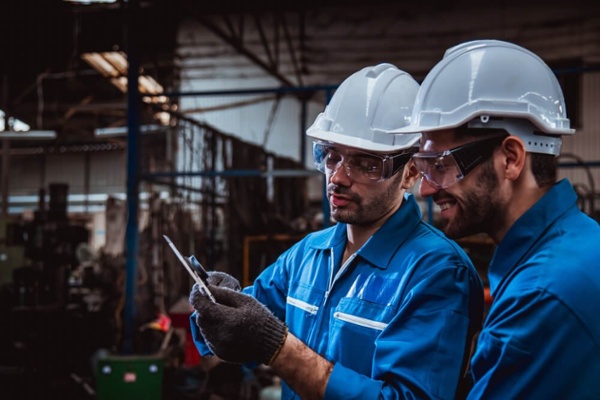In Part 1, we looked at ways automation changes the tasks and work at a manufacturing facility. In this post, we’ll discuss the human side.
Robotics and automation affect workplace culture in terms of how work is done but also how employees view their work and their value to the company. Most will be accepting of new equipment and procedures, some sooner and some later. If morale and workplace culture are positive, the changes go more smoothly.
We think it’s worth putting some thought into how you introduce, train, and incorporate automation into your organization. Morale is highest when workers feel their concerns are heard, that they’re valued, and that the company wants them to succeed. After all, you can always replace or upgrade machines, but your employees are the heart of your business.
Here are three things to keep in mind when automation equipment and people mix in the workplace:
1. People Won’t Feel Good About Working for You If They Don’t Feel Safe
Most employees have both real and perceived concerns about safety when dealing with new equipment. Encouraging people to share their concerns and addressing how likely those things are to happen (or not) helps them trust the equipment and your judgement in buying it.
Don’t assume everyone knows how safety devices operate. Be direct and clear about how safeguards, such as two-part controls, lock-out/tag-out key systems, and sensors work. And be sure everyone knows these mechanisms are required, not just suggested: no propping open gates or guards.
No automated equipment is inherently safe, even user-friendly collaborative robots or self-propelled conveyors. Ensure everyone who will come into contact with the workstation is aware of the basics for staying safe, even those from different departments who aren’t around it often.
Another aspect of safety is ergonomics. Automating physically demanding tasks or making them easier to perform over and over lowers the risk of injury and keeps workers comfortable on the job. It also makes people happier with their work and helps develop positive associations with the equipment. The added benefit of ergonomic design is that it makes jobs become easier for older or physically challenged employees.
Posting reminders, warnings, and simple directions for safety procedures reinforces that safety is a priority. And always confer with your company safety inspectors for best practices and matters of compliance.
2. Widespread Buy-in Takes Intention and Planning

There are always some obstacles to universal buy-in for robotics and automation. Fears about job security are a big one, but employees may also worry the equipment is too complicated to understand, that it’s easier for younger or newer employees, or that it is easily broken or damaged.
Bringing the entire organization on board should be a thoughtful process, including:
- Keeping workers informed about how the transition is going and major milestones
- Being open to questions and answering them directly
- Emphasizing the big picture – how automation helps productivity and resiliency
- Addressing concerns about job security and work assignments
- Providing hands-on opportunities to get familiar and comfortable with the equipment
- Soliciting feedback from operators and other manual laborers, who will probably feel the changes most acutely
- Talking with engineers to assure them their work will not be interrupted or derailed by programming or troubleshooting equipment or by changes to the workflow
If it’s your facility’s first time with robotic equipment, the adjustment could take months instead of weeks, and that’s okay: employee morale is an even bigger investment than the equipment.
Learn More in our eBook: Working with an Automation Vendor
3. A Well Trained Employee Is More Productive

No one likes feeling like they don’t know enough to do their job well. Or that they wouldn’t know what to do if their equipment malfunctioned. Add a shiny, new high-tech robot to the mix and the potential for anxiety is high.
Training for automation and robotic equipment should be comprehensive so workers know how to operate it, but also so they’re comfortable and confident using it. That includes day-to-day physical tasks involving the machine, the human-machine interface (HMI) and any computers or handheld controls, basic troubleshooting, and how to monitor critical data (and what the various numbers signify).
Include additional training or an opportunity for review whenever there is an upgrade, and consider offering advanced training on the equipment to build a culture of continuous learning. This shows you are invested in their success.
Keep in mind that training isn’t one-size-fits-all. It’s worth the extra time it takes to provide supplemental help when and where you can: make a video tutorial, post written instructions, or let employees shadow each other. Remember that integrating new skills is often more about personality than age or other factors.
Adding automated equipment and systems to your facility is an opportunity to build a culture of safety, mutual communication, and knowledge. That’s what makes employees feel valued and creates an atmosphere of teamwork, even if the nature of the work and the physical layout has changed.
Are you ready to get started? Let’s talk



